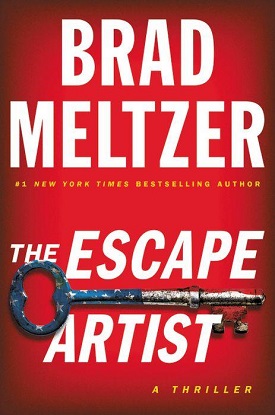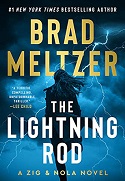 Synopsis:
Synopsis:
Who is Nola Brown?
Nola is a mystery.
Nola is trouble.
And Nola is supposed to be dead.
Her body was found on a plane that mysteriously fell from the sky as it left a secret military base in the Alaskan wilderness. Her commanding officer verifies she’s dead. The US government confirms it.
But Jim “Zig” Zigarowski has just found out the truth: Nola is still alive. And on the run.
Zig works at Dover Air Force Base in Delaware, helping put to rest the bodies of those who die on top-secret missions. Nola was a childhood friend of Zig’s daughter, Maggie, and once saved Maggie’s life. So when Zig realizes Nola is still alive, he’s determined to find her. Yet as Zig digs into Nola’s past, he learns that trouble follows Nola everywhere she goes.
Nola is the U.S. Army’s artist-in-residence — a painter and trained soldier who rushes into battle, making art from the aftermath of war and sharing observations about wars that would otherwise go overlooked. On her last mission, Nola saw something nobody was supposed to see. It earned her an enemy unlike any other who will do whatever it takes to keep Nola quiet.
Together, Nola and Zig will either reveal a sleight of hand being played at the highest levels of power . . . or die trying to uncover the U.S. Army’s most mysterious secret — a centuries-old conspiracy that traces back through history to the greatest escape artist of all: Harry Houdini.
Review:

Meltzer also writes nonfiction books, including The First Conspiracy, about a secret plot to kill George Washington, and The Lincoln Conspiracy: The Secret Plot to Kill America’s 16th President — And Why It Failed. His Ordinary People Change the World children’s series features volumes titled I Am . . . various personal characteristics like “strong” or heroic, influential people like Lucille Ball, George Washington, Walt Disney, and Martin Luther King, Jr., just to name a few. Meltzer is one of only a few authors who have had books on the bestsellers list for nonfiction, advice, children’s books, and comic books.
Meltzer says that inspiration for The Escape Artist came to him from different sources. First, he learned that beginning with World War I the U.S. Army has artists-in-residence — painters who recreate scenes of conflicts and catastrophes, capturing the moments and emotions, and preserving them for history in their unique style. He also learned that a friend of magician Harry Houdini’s, John Ebert Wilkie, was named head of the U.S. Secret Service in 1928. He employed some of Houdini’s tricks to improve on the Secret Service’s surveillance efforts. And Meltzer became interested in learning more about Dover Air Force Base. Situated in Delaware, it is where the bodies soldiers and undercover operatives who are killed overseas are identified and prepared for release to their families and burial. The military’s biggest and most sensitive cases are also handled out of Dover. So, for instance, the bodies of the astronauts tragically killed in the Space Shuttle debacle were taken there, as were those of September 11 victims who died at the Pentagon. Meltzer immediately recognized “Dover is a place full of secrets.”
Somehow, after performing his usual extensive research, Meltzer cohesively melded all of those elements into a fast-paced and engrossing thriller featuring a cast of fascinating, fully developed characters.
As the story opens, a twin engine plane leased by the military takes off carrying several VIP passengers, but soon crashes. Three of the victims have the same names as some of Harry Houdini’s assistants, all of whom have been dead for at least a century. Coincidence? Nola Brown, a staff sergeant in the U.S. Army who serves as one such artist-in-residence, is believed to have also died in the crash. She was a childhood friend of Maggie Zigarowski, the daughter of Jim “Zig” or “Ziggy” Zigarowski, a forensic pathologist who works as a mortician at Dover Air Force Base. The girls were in the same Girl Scout troop and Nola actually once saved Maggie’s life.
Following the plane crash, Zig is assigned to prepare Nola’s remains. While doing so, he finds a note inside the corpse. “Nola, you were right. Keep running,” it says. The body of the young woman who perished in the crash is not that of Nola Brown, after all. So why was the dead woman identified as Nola? And where is the real Nola? Readers soon learn that she is the escape artist referenced in the title. But what is she running from? Or who? And if Nola didn’t die in the crash, who did? And why?
Zig spends most of his waking hours among the dead. Morticians like Zig are artists in their own right. He and his colleagues spend countless hours restoring the fallen so that their family members can view them one last time and say their good-byes. To Meltzer, Zig represents “real heroes, working on the best of the best and giving them peace.” In Zig, Meltzer has crafted a character who shoulders an enormous responsibility to the dead he prepares to meet their loved ones, as well as their grieving family and friends. Unlike Meltzer, he doesn’t see himself as a hero, but strives to honor the heroes who are entrusted to his care and respectfully does his utmost to ensure that they look their best one last time. Zig has experienced the greatest personal loss imaginable — the death of his own daughter, Maggie — and carries a tremendous amount of guilt about the circumstances. He is as bereft as the families he serves, missing the life he once enjoyed with his daughter, Maggie, and now ex-wife, Charmaine.
Because Zig recognizes Nola’s connection to Maggie, he is determined to learn Nola’s whereabouts and what or who she is determined to escape from. It is Zig’s fundamental nature to help — the deceased, their families, and Nola. In part because he can no longer help the beloved daughter he and Charmaine lost. What Zig doesn’t realize is that because of everything she has been through, Nola is strong, determined, self-reliant, and extremely clever and resourceful. She is also mysterious, desperate, and calculating. Perhaps it is Zig who will ultimately need help and Nola will be the one who provides it.
Meltzer has always been known for his meticulously researched, inventive and ingenious thrillers. But with The Escape Artist he has achieved a new level of storytelling excellence. Zig is a sympathetic character — a broken man who is grieving the loss of his only child and the subsequent collapse of his marriage, but trying to carry on. He is honorable and ethical, with deep appreciation and admiration for those who make the ultimate sacrifice to their country. After he finds convincing evidence that the dead woman he is preparing for burial cannot be Nola, he is determined to find out why the Army seems intent on making it appear that Nola did, in fact, die in the crash. Zig is not a trained investigator and his forays into finding answers are fraught with danger and near-misses. Meltzer believably and compelling contrasts Zig’s naivete with Nola’s cunning . . . to exquisite result. In his unique signature style, Meltzer injects colorful supporting characters into the story, along with snappy, rapid-fire dialogue and a heathy dose of humor, all of which keep the story moving forward at a breakneck pace. As always, Meltzer’s plot is nothing short of diabolical and readers will be guessing the truth right up to the last page. Because, in Meltzer’s story, the Army does indeed have a secret that can be traced all the way back to the days of Houdini. Zig and Nola are forced to work together and stay alive to follow the clues and discover the truth.
The Escape Artist is an entertaining adventure founded upon obscure trivia, actual historical events, and real locations brought to life through the style of imaginative story-telling for which Meltzer has long been known.
Excerpt from The Escape Artist
PROLOGUE
Copper Center, Alaska
These were the last thirty-two seconds of her life.
As the small plane — a twin-engine CASA contracted by the military — took off from the airfield, most of the seven passengers on board were staring out their windows, thinking themselves lucky. Few people got to see this side of the world, much less the private base that the army had built out here. On maps, it didn’t exist. On Google, it was permanently blurred.
In the last row of the plane, a woman with shoulder-length black hair was convinced she was blessed, marveling at the snow-dusted tops of Alaska’s beautiful aspen trees. She loved that the roots of aspen trees often grew together, supporting each other and forming a giant organism. It was why she joined the army all those years ago: to build something stronger, with others. She got just that when she came out here to the lush wilderness.
Definitely blessed, she told herself. Then, just like that, the plane began to vibrate.
Her initial reaction was, Fix it — straighten us out. She was annoyed that the vibrations were messing up her handwriting. On the open tray table, she was trying to write a letter — a dirty note — to her fiancé, Anthony, telling him what she was planning to do to him later that evening.
Her hope was to slip it into his back pocket, Anthony being so surprised—and horny—from her traveling all the way to Fort Campbell on his birthday, he wouldn’t notice her sliding some playful fun into his pocket. And even if he did, well…Thanks to their army schedules, she and Anthony hadn’t been alone with each other in two months. He’d have no problem with a pretty girl’s hand on his ass.
The intercom cracked to life. “Prepare for —”
The pilot never got the words out.
The plane tilted, nose down, like it was arcing over the peak of a roller coaster. The woman with the black hair felt her stomach twist. All that was left was the final drop. Suddenly, there were anvils on her shoulders, pressing her into her seat.
Diagonally across the aisle, an Army lieutenant with buzzed red hair and triangular eyes made a face and gripped his armrests, just beginning to realize how bad it was about to get.
The woman with the black hair was Army too—a twenty-seven-year-old supply sergeant—and on those first days of her Airborne training at Fort Benning, they taught her that when it comes to a plane crash, people don’t panic. They become docile and silent. To save yourself, you need to take action.
The plane jolted, nearly knocking the pen from her hand. The pen. Her letter. She almost forgot she was writing it. She thought about Anthony, about writing a will . . . Then she replayed those last few minutes before she got on board. Oh, God. Now it made sense. Her stomach was up in her throat. The VIPs at the front of the plane were now screaming. She knew why this plane was going down. This wasn’t an accident.
Frantically, she jotted a new note, her hand shaking, tears squeezing out from behind her eyes.
The plane jolted again. A fireball of jet fuel came in through the emergency door on her left, from outside. Her shirt was on fire. She patted it out. She could smell melting plastic, yet at the sight of the flames —
The door. She was seated at the emergency exit.
Still clutching tight to the scribbled note, she gripped the door’s red handle with both hands and started to pull. It gave way, and she slid it sideways. There was a pop. The door was still closed, but the seal was broken.
Twenty seconds to go.
She tried to get out of her seat, but her seat belt — It was still buckled. In a frenzy, she clawed at it. Click. She was free.
Still holding the crumpled note, now damp in her sweaty fist, she put her palm to the exit door and gave it a shove. It was stuck from the fire. She gave it a kick. The door opened as a rodeo of wind whipped her black hair in every direction. Papers went flying through the cabin. A phone bounced against the ceiling. People were screaming, though she couldn’t make out any of it.
Fourteen seconds to go.
Outside, the tall, snow-covered aspen trees that had looked so small were now racing at her, growing larger every second. She knew the odds. When you free-fall in a light aircraft, if fate’s not on your side, you don’t have a chance.
“GO! GET OUT!” a man’s voice shouted.
She had barely turned as the lieutenant with the triangular eyes barreled into her, fighting to get to the emergency exit.
The plane was in free fall now, a reddish orange smoke filling the cabin. Eleven seconds to go. The man was pushing against her with all his weight. They both knew if they jumped too soon—above three hundred feet—they wouldn’t survive the impact. Even if they were lucky enough to live, the compound fractures in their legs—if the bones came through their skin—it’d make them bleed out in no time.
No. This had to be timed just right.
Not until you’re at the treetops, she told herself, remembering her training and eyeing the aspens, which were closer than ever. The wind blinded her. The smoke was in her lungs as she held the lieutenant at bay with one hand and held tight to the note with her other.
“GO! NOW!” the man screamed, and for a moment, it looked like his back was on fire.
Eight seconds to go.
The plane plummeted diagonally toward the ground. Without even thinking about it, she stuffed the note into the one place she thought it might survive.
“WE DON’T HAVE –!”
Six seconds.
She put her foot on the lip of the doorway, turned back to the lieutenant, and grabbed him by his shirt, trying to pull him outside with her. This could work. She could save them both.
She was wrong.
The lieutenant pulled away. It was instinct. No one wants to be yanked from a plane. That was the end. The lieutenant with the triangular eyes would go down, literally, in flames.
With three seconds to go, the woman with black hair leapt from the plane. She would land on the balls of her feet, still trying to follow her training as she hit with a thud in the snow. A perfect landing. But also a deadly one. She’d break both legs and snap her neck on impact.
The emergency crews would find her name on the manifest. Nola Brown.
And the scribbled note — her final words — that she’d hidden so well? That would be found by the least likely person of all.




Comments are closed.